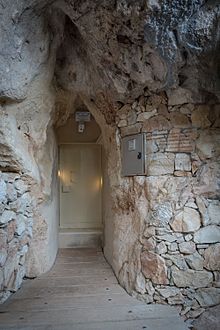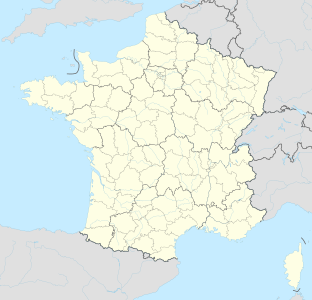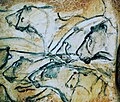Chauvet cave
| Chauvet cave
|
||
|---|---|---|
|
Representations of aurochs , horse heads and woolly rhinos on the cave walls |
||
| Location: | Vallon-Pont-d'Arc , Region Auvergne Rhône-Alpes , Ardèche , France | |
| Height : | 180 m | |
|
Geographic location: |
44 ° 23 '17.2 " N , 4 ° 24' 58.1" E | |
|
|
||
| Geology: | limestone | |
| Type: | Karst cave | |
| Discovery: | December 18, 1994 | |
| Overall length: | 600 m | |
| Particularities: | UNESCO World Heritage Site since 2014 | |
| Website: | http://archeologie.culture.fr/chauvet/fr (French, English, Spanish) | |
The Chauvet Cave ( French Grotte Chauvet ) is located near the small town of Vallon-Pont-d'Arc in France in the Ardèche river valley . The cave, discovered in 1994, is one of the world's most important archaeological sites with cave paintings and incised drawings . So far more than 400 murals with around 1000 painted and engraved animal and symbol representations have been recorded.
The charcoal used for the drawings has inconsistent dates from 1995–1996, with an average age of more than 30,000 years, which would correspond to the archaeological culture of Aurignacien . In a publication from 2012, systematic methodological errors in the radiocarbon data of the French laboratory were explained, whereby the works of art would have to be dated to Gravettia several millennia younger if the error was corrected . According to the latest radiocarbon dating, there were two periods of human use, an older one from 35050–31550 BC. Chr. (Aurignacien?), A younger from 29050–26050 BC. BC (Gravettia).
In June 2014, the Chauvet Cave was added to the UNESCO World Heritage List .
Location and geology
location
The Chauvet Cave is located about three kilometers from the small town of Vallon-Pont-d'Arc in the direction of Saint-Martin-d'Ardèche in the Ardèche department in southern France. It is located on the southern slope of a dry former loop of the Ardèche river, the Cirque d'Estre. This breakthrough came about when the Ardèche broke through the natural limestone barrier at the narrowest point of the river bend in the Old Pleistocene , created the Pont d'Arc and drained the Cirque d'Estre.
Emergence
Before, in the lower Pliocene , the Chauvet Cave was created as an underground shortcut through the karst from the northern Paleo river course of the Ardèche (today the last section of the Ibie river ) to the Cirque d'Estre. Today's cave formed the mouth of the spring. When the Ardèche returned to another altitude due to changing sea levels in the wake of the Messinian salinity crisis , large parts of the Chauvet Cave were closed by calcite deposits .
expansion
The cave is of a size previously unknown in the Ardèche. Today's access is initially a very narrow horizontal tunnel, at the end of which there is a vertical descent of a good ten meters. The actual cave can be entered largely effortlessly over a length of more than 500 meters. The cave floor only sinks about 24 meters from front to back. The horizontal extension extends over an area of around 240 × 100 meters, it includes four large halls 12-17 meters high, the largest room measures almost 40 × 60 meters. The currently mapped total area of the cave is around 8140 square meters.
discovery
The cave was discovered on December 18, 1994 by speleologists Jean-Marie Chauvet , Éliette Brunel Deschamps and Christian Hillaire. It is not open to the public, as a change in humidity could lead to fungal attack and thus endanger the paintings. This experience was made in the mid-1960s in the Lascaux cave and in the late 1970s in the Altamira cave , the access to which has also been strictly regulated since then. Even the authorized researchers are only allowed to work there for a few hours at intervals, namely for four weeks in spring and two weeks in autumn.
Age of use
The discoverers of the Chauvet Cave first published that they had found the oldest cave paintings in the world. In the meantime, however, the paintings in the Spanish El Castillo cave and the karst caves in the Maros administrative district on Sulawesi are even older.
A modern forgery can be ruled out due to the sintering of the paint and the unchanged base. The dating of cave paintings is problematic, however, as many pigments cannot be dated. Critics point out that the radiocarbon method of the charcoals used for painting does not automatically date the pictures and the charcoals can theoretically be much older, i.e. only represent the term post quem for the paintings. Therefore, charcoal could already have come from cave fires in the Aurignacia, but was only used for painting in the Gravettia. Due to the living floor (the unchanged condition of the cave floor since the last visit in Gravettien) it is certain that there has been no (further) painting of the walls for at least 20,000 years.
Due to their stylistic features, however, some of the paintings were classified as younger than using physical dating methods. A comprehensive assessment of all dated artifacts and fossils (from more than 350 samples) has been available since 2016, which were obtained with one of the following three isotope dating methods : radiocarbon dating , uranium-thorium dating and 36 Cl dating .
Paintings
Depictions of a cave hyena and a panther
Woolly rhinoceros with two horns
Replica of the engraving of a snowy owl , Brno Anthropological Museum
Replica of painted cave lions in the Brno Museum
State of preservation
Since the original cave entrance was suddenly closed to the outside world by a falling rock wall during the Würm Ice Age (around 22,000 years ago), the unique, very vivid-looking treasure trove of images of the Chauvet Cave has been preserved in a very good condition. It contains masterpieces of Paleolithic cave art .
Representations
The unique beauty and harmony of the paintings in the Chauvet cave are remarkable. The experienced handling of the available paints (initially charcoal, but also red and lighter ocher), the stylistic devices used (up to the representation of movement), and the composition of sometimes extensive picture walls are astonishing. The relief of the rock face was used again and again to present images effectively. The colors used were made on site from charcoal, natural ocher and clay, etc.
Animals
The animals depicted are of a remarkable variety. Animals that would fight in the wild appear in peaceful coexistence in screens up to 12 meters wide. The discoverers have already recorded over four hundred depictions of animals. The following glacial species are found in the Chauvet cave, woolly rhinos , cave lions , mammoths , wild horses , cave bear , cave hyena , reindeer , bison , bison , aurochs , ibex , giant deer , deer , panther and a snowy owl .
The representations are accurate down to the smallest details and movement sequences. The frequent depiction of animal species, such as woolly rhinoceros , felids and cave bears , that were previously rarely found in cave paintings is astonishing .
Representations in which the duplication of the body outlines either signal sequences of movement or pairs of animals are striking.
Contrary to earlier hypotheses, by no means only the common hunted animals were shown (for example in order to be able to kill them better). It is also about animals that are dangerous to humans in nature or can inspire fear. However, none of these animals appear hostile, angry or aggressive to the viewer. On the contrary, it is noticeable that especially the affection among animal pairs, including non-conspecifics, was discussed.
character
As in other surrounding caves, many stylized representations and signs can be found in Chauvet Cave. The hybrid creatures and sexual symbols shown deserve special attention (the pubic triangle appears several times, once with a phallus ), and the presentation of a couple with a common human abdomen, above which the female partner is a lioness and the man a bison. The meaning of the hand negatives and positives found in the Cosquer Cave is still unclear.
Purpose of the paintings
For at least 6000 years, not only were more images and paintings added to the cave . The research results so far indicate that the paintings were important in the context of cult acts and initiation rites .
Animal remains
The Chauvet Cave is also of exceptional paleontological interest. The large number of bone fragments and skulls come largely from cave bears, of which not only a footprint (a paw print of 15 × 17 centimeters, without the claws), but also hollows of the winter resting places have been preserved in the cave clay . In contrast, there are hardly any bones from mammoths, while a number of rock drawings depict these animals.
Human footprints
Inside the cave there are numerous footprints that have been preserved in the damp clay. Research is currently being carried out into whether dog tracks can already be identified here.
For more than 70 meters one can follow the footprint of an approximately eight-year-old, probably male, adolescent. The child struck his fire torch on the cave wall at regular intervals to increase the brightness. The C14 test of the coal remains showed an age of 26,000 years. It has been suggested that the boy was a Neanderthal man who used the cave and its surroundings as a refuge .
The cave seems to have been used by cave bears in the winter months. People only stayed in the cave for a very short time. Traces of longer stays could not be detected.
Exploration and conservation

The excellent state of preservation of the works of art and the cave floor prevents the cave from being open to general visits, at least for the next few decades. A group of around 20 scientists from various disciplines is currently working to unravel some of its secrets. The work on site is very precisely regulated and monitored by means of climate sensors in order not to endanger the existing cave climate.
Dispute over the image rights
After the discovery of the cave, the discoverers took photographs of all the images in the hope of being able to use them commercially. The state responded very quickly and denied the discoverers any rights. This resulted in a long-term legal dispute that ended in a settlement in February 2000 . In it, the French state recognized the discovery as a private, accidental event and Chauvet, Brunel Deschamps and Hillaire were granted the rights associated with it.
exhibition
Immediately after the discovery of the Chauvet cave, the National Museum of Natural History in Paris set itself the task of making these extraordinary works of art accessible to an interested public: Together with various partners, above all the three discoverers of the cave and the community leaders of Vallon Pont d'Arc, an exhibition was created in this city : it has been open all year round since June 3, 1995.
Visitor center
On April 25, 2015, a replica of the cave and a visitor center opened at great expense for 55 million euros, three kilometers away to protect the original .
Movie
In 2010, the director Werner Herzog shot the 3-D documentary Cave of Forgotten Dreams about the cave. The film premiered at the 2010 Toronto International Film Festival. The film was shown in cinemas in England and the USA from March 2011. In Germany, the documentary was shown under the title The Cave of Forgotten Dreams from November 2011. The German version was produced by TV + Synchron Berlin.
The drawings of the cave were also the inspiration for the French animated short film Traces of Sophie Tavert and Hugo Frassetto, made in 2018 and produced by Les Films Du Nord .
See also
literature
- H. Bocherens, D. Drucker, D. Billiou: Etat de conservation des ossements dans la previous grotte Chauvet (Vallon-Pont-d'Arc, Ardèche, France). In: Bulletin de la Société Préhistorique Française 102, 2005, ISSN 0037-9514 , pp. 77-87.
- Jean-Marie Chauvet, Éliette Brunel Deschamps, Christian Hillaire: Chauvet Cave. The Discovery of the World's Oldest Paintings. Thames and Hudson, London a. a. 1996, ISBN 0-500-01706-9 .
- 1995: Grotte Chauvet near Vallon-Pont-d'Arc: Paleolithic cave art in the Ardèche valley. Jan Thorbecke, Stuttgart 2001, ISBN 3-7995-9000-5 .
- Jean Clottes (Editor), La Grotte Chauvet. L'art des origins. Seuil, Paris 2001, ISBN 2-02-048648-2 ( Arts rupestres ).
- J. Clottes, M. Azéma: Les images de félins de la previous grotte Chauvet. In: Bulletin de la Société Préhistorique Française 102, 2005, ISSN 0037-9514 , pp. 173-182.
- Jean Courtin: The Forgotten Cave. Novel. Piper, Munich 2000, ISBN 3-492-23035-0 .
- Paul Pettitt : Art and the Middle-to-Upper Paleolithic transition in Europe. Comments on the archaeological arguments for an early Upper Paleolithic antiquity of the Grotte Chauvet art. In: Journal of Human Evolution 55, 2008, 5, ISSN 0047-2484 , pp. 908-917.
- Éliette Brunel, Jean-Marie Chauvet, Christian Hillaire: The discovery of the Chauvet-Pont d'Arc cave. Editions Equinoxe, Saint-Remy-de-Provence 2014, ISBN 978-2-84135-868-7 .
Web links
- La Grotte Chauvet 2 Ardèche - the publicly accessible replica
- Chauvet Pont d'Arc - Cave Ardèche , archeologie.culture.fr (in English, French and Spanish)
- uf.uni-erlangen.de: Grotte Chauvet Archaeologically Dated (Christian Züchner, University of Erlangen , Institute for Pre- and Protohistory , Critique of the Dating Approach, English)
- La grotte Chauvet , film contribution, France 3 , 23 April 2013
- Chauvet grotto was settled about 37,000 years ago . Bayerischer Rundfunk, April 11, 2016 (with audio reports and numerous images)
Individual evidence
- ↑ Chauvet Grotto [1]
- ^ A b J. Combier, G. Jouve: Chauvet cave's art is not Aurignacian: a new examination of the archaeological evidence and dating procedures. In: Quartär , Volume 59, 2012, pp. 131–152. doi: 10.7485 / QU59 05 .
- ↑ Anita Quil et col, "A high-precision chronological model for the Upper Paleolithic decorated cave of Chauvet-Pont d'Arc, Ardèche, France," PNAS, avril 2016 (DOI 10.1073 / pnas.1523158113)
- ↑ Valladas, H., Tisnérat-Laborde, N., Cacher, H., Kaltnecker, É., Arnold, M., Oberlin, Ch. Et Évin, J. (2005) - «Bilan des datations carbone 14 effectuées sur des charbons de bois de la grotte Chauvet [archive] », Bulletin de la Société Préhistorique Française, t. 102, no 1, La grotte Chauvet à Vallon-Pont-d'Arc: un bilan des recherches pluridisciplinaires Actes de la séance de la Société préhistorique française, 11 and 12 octobre 2003, Lyon, p. 109-113
- ↑ a b Ludovic Mocochain, Philippe Audra, Georges Clauzon, Olivier Bellier, Jean-Yves Bigot, Olivier Parize, Philippe Monteil: The effect of river dynamics induced by the Messinian Salinity Crisis on karst landscape and caves: Example of the Lower Ardèche river ( mid Rhône valley). In: Geomorphology , Volume 106, 2009, pp. 46-61.
- ^ Jean-Marie Chauvet, Éliette Brunel Deschamps, Christian Hillaire: Chauvet Cave. The Discovery of the World's Oldest Paintings. Thames and Hudson, London et al. 1996, ISBN 0-500-01706-9 .
- ↑ M. Aubert, A. Brumm, M. Ramli, T. Sutikna, EW Saptomo, B. Hakim, MJ Morwood, GD van den Bergh, L. Kinsley, A. Dosseto: Pleistocene cave art from Sulawesi, Indonesia. In: Nature , Volume 514, October 9, 2014, pp. 223-227, doi : 10.1038 / nature13422 .
- ^ Christian Züchner: Grotte Chauvet Archaeologically Dated. Communication at the International Rock Art Congress IRAC ´98 - Vila Real - Portugal (6-12 September 1998). ( Online version ), website Prehistory and Early History of the University of Erlangen (accessed December 18, 2014).
- ^ A b c Robert G. Bednarik: Antiquity and authorship of the Chauvet rock art. In: Rock Art Research , Volume 24, No. 1, 2007, pp. 21-38.
- ↑ Anita Quiles, Hélène Valladas, Hervé Bocherens, Emmanuelle Delqué-Količ, Evelyne Kaltnecker, Johannes van der Plicht, Jean-Jacques Delannoy, Valérie Feruglio, Carole Fritz, Julien Monney, Michel Philippe, Gilles Tosello, Jean Clottes, Jean-Michel Geneste : A high-precision chronological model for the decorated Upper Paleolithic cave of Chauvet-Pont d'Arc, Ardèche, France. In: PNAS , Volume 113, No. 17, April 26, 2016, pp. 4670-4675, doi : 10.1073 / pnas.1523158113 .
- ^ Jean-Marie Chauvet, Éliette Brunel Deschamps, Christian Hillaire: Grotte Chauvet near Vallon-Pont-d'Arc. Paleolithic cave art in the Ardèche valley. Jan Thorbecke, Stuttgart 1995, 3rd edition 2001, ISBN 3-7995-9000-5 .
- ↑ Michel-Alain Garcia: The trail of human footprints at Chauvet Cave in the Pont-d'Arc Valley. In: Excerpts from the INORA International Newsletter on Rock Art , No. 24, 1999
- ↑ Éliette Brunel, Jean-Marie Chauvet, Christian Hillaire: The discovery of the Chauvet-Pont d'Arc cave. Editions Equinoxe, Saint-Remy-de-Provence 2014, p. 70, ISBN 978-2-84135-868-7
- ↑ Making of "traces" - Interview with Sophie Tavert and Hugo Frassetto. Retrieved October 18, 2019 .











